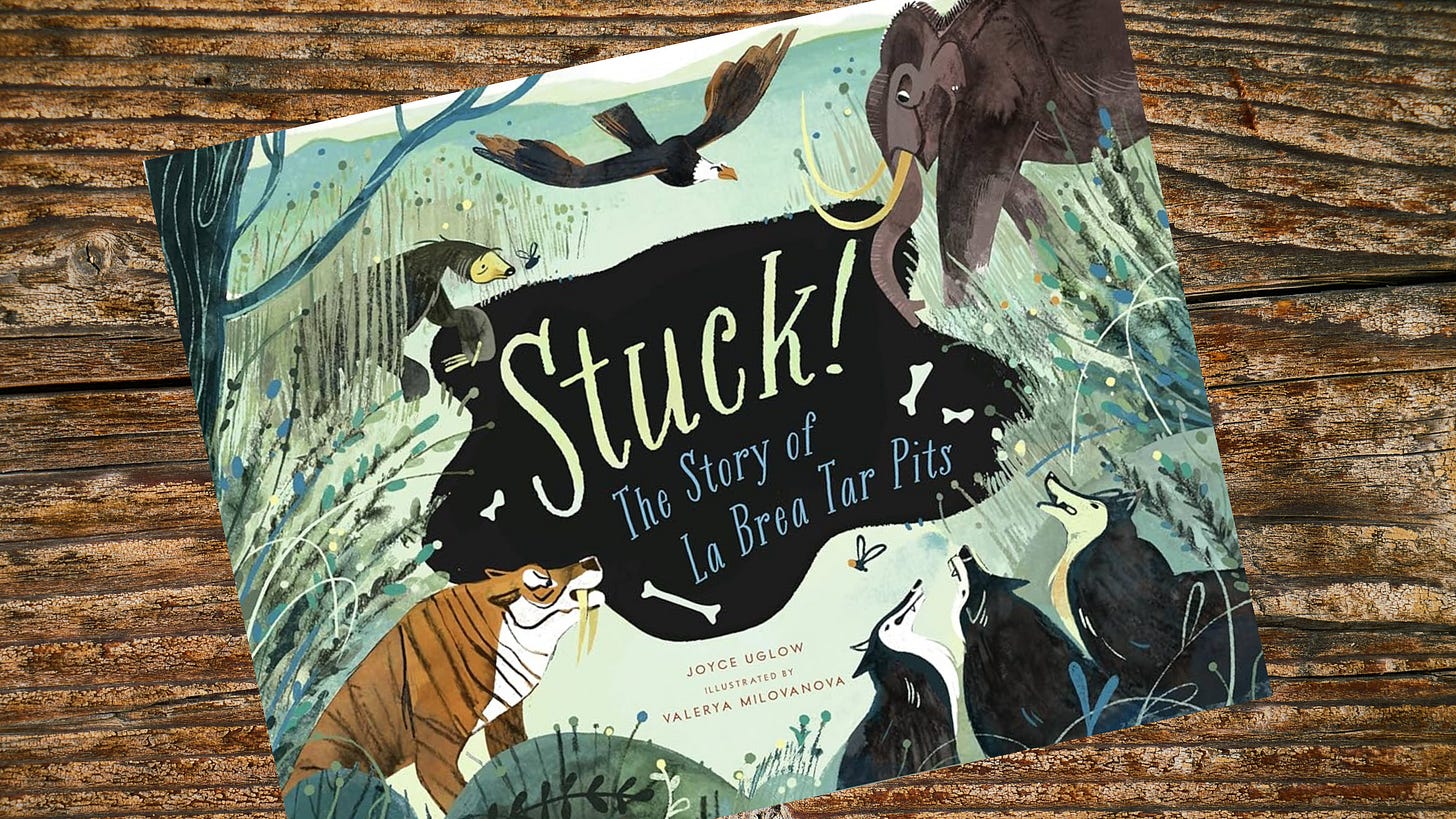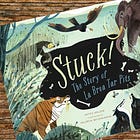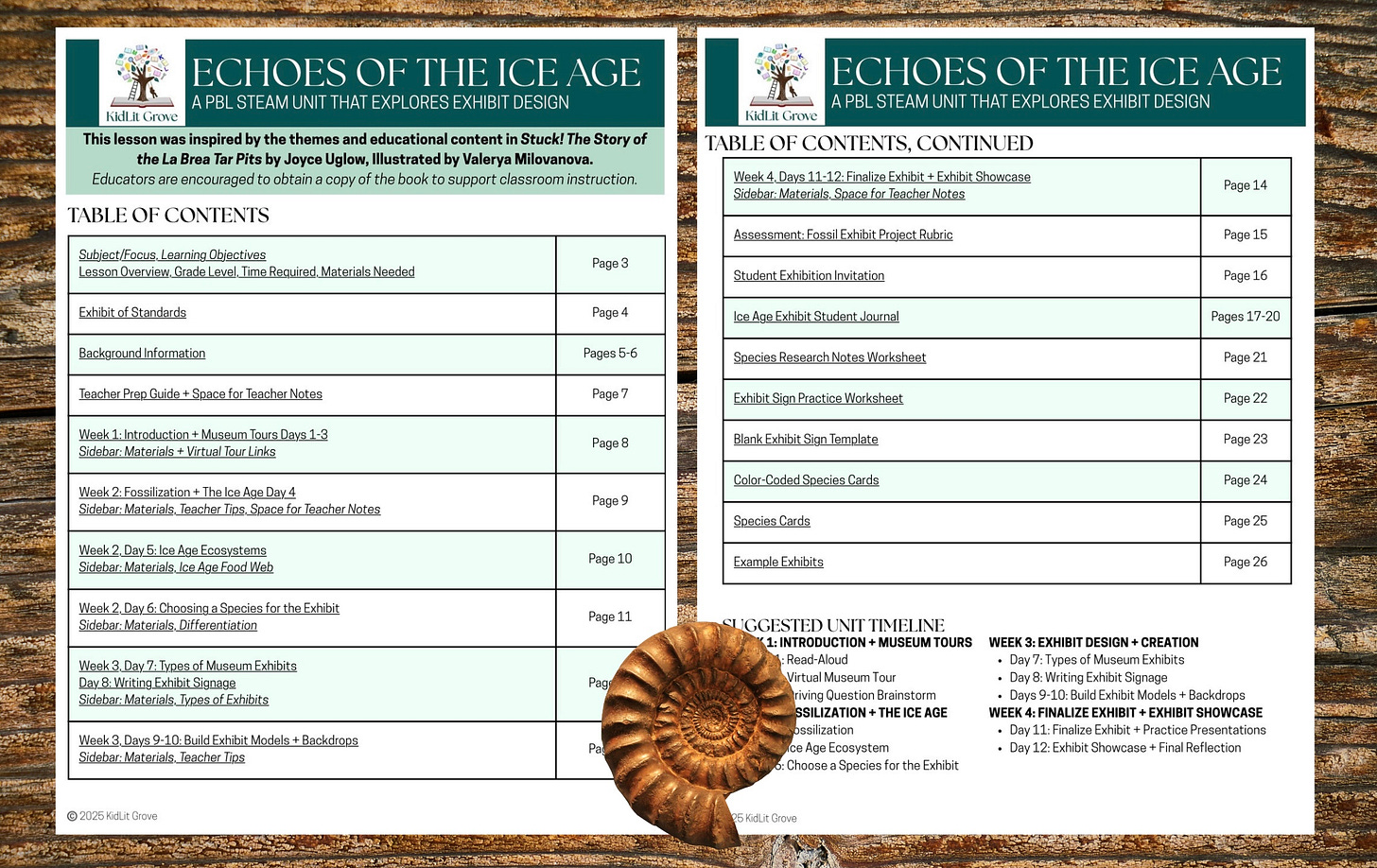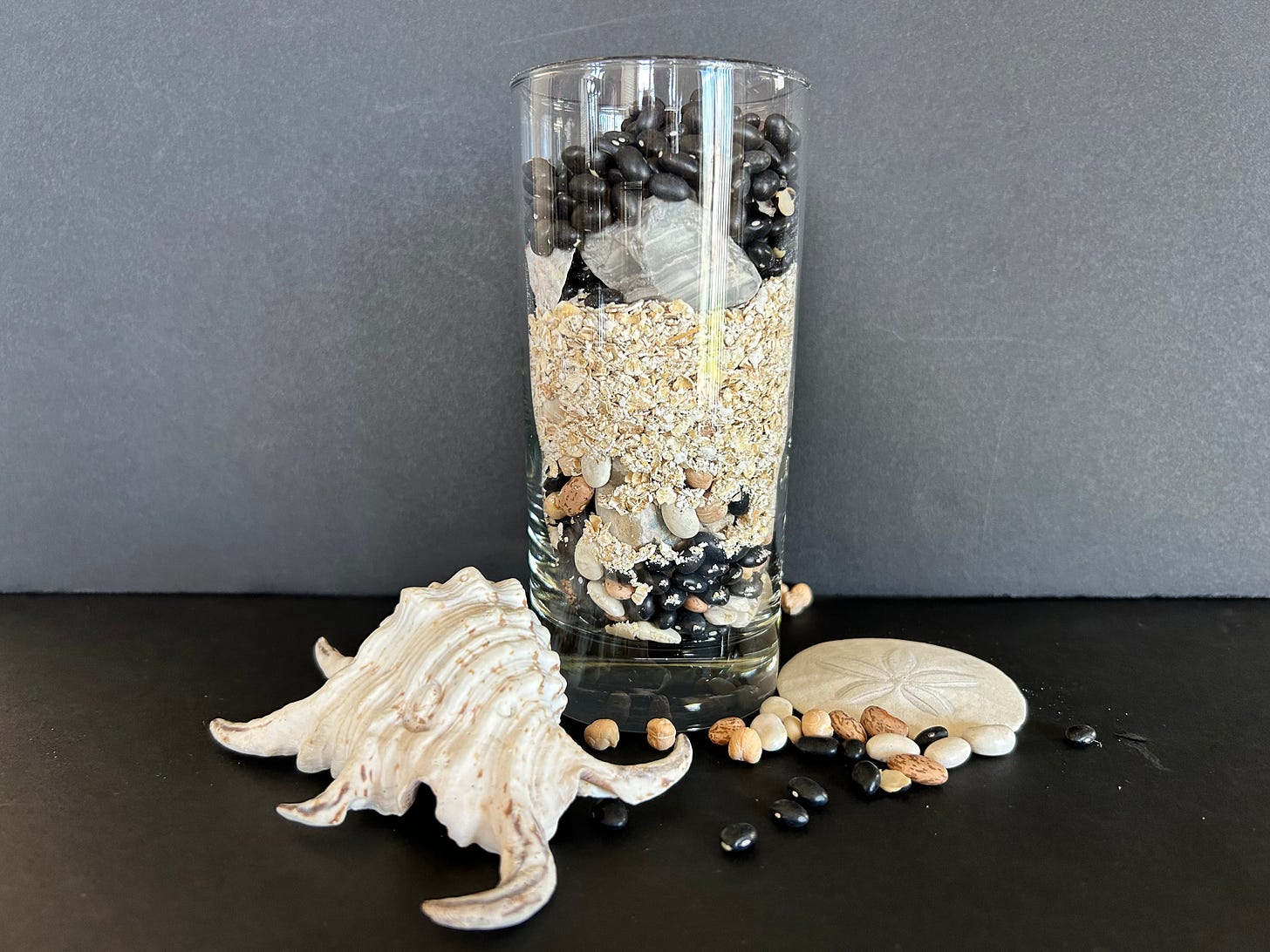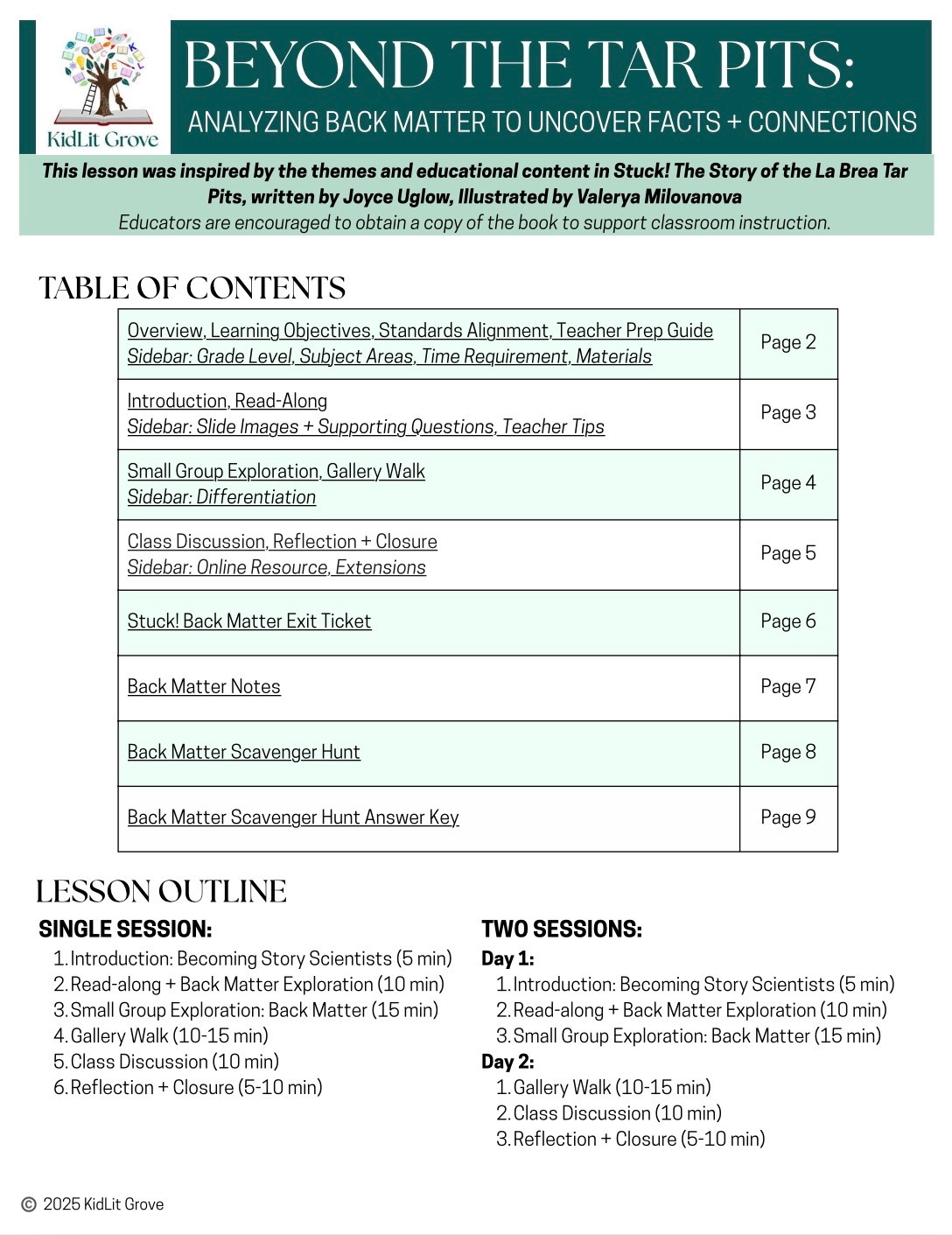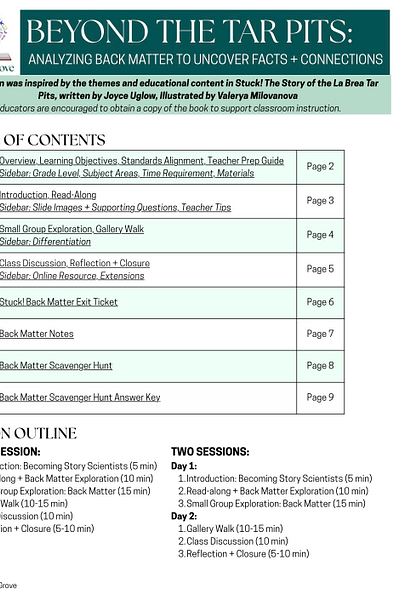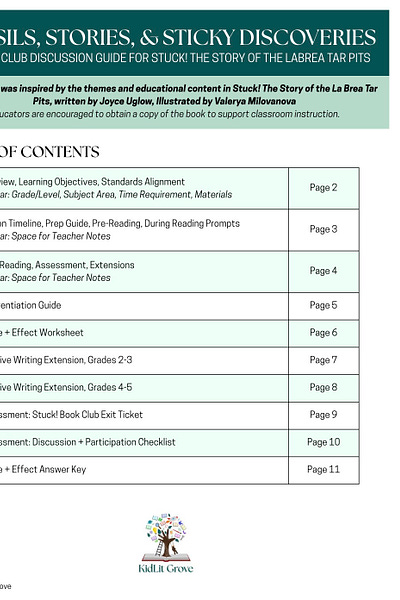Digging into the Past: Teaching Fossils, Stories, & Science through “Stuck! The Story of La Brea Tar Pits”
Discover cross-curricular lessons on fossils, ecosystems, and narrative craft with ready-to-teach guides and hands-on extensions across grade levels K-5.
When I was little, I went through a full-blown dinosaur phase. I still feel a spark of excitement every time I see a dinosaur exhibit. There’s just something awe-inspiring about uncovering a creature that once roamed the earth. How amazing would it be to excavate a once-living being from the prehistoric past?
Years ago, I had the chance to design a small exhibit while working at the Great Lakes Aquarium. It was part of a larger “Origin of Species” exhibit, highlighting the ancient life and geologic history of Lake Superior. I sourced fossils from local collectors, labeled each one, and arranged them for visitors to explore up close.

In sourcing fossils, I’ll never forget visiting the iron mines of Northern Minnesota and learning that miners used to toss ammonites (some the size of tractor tires!) straight into the rock grinder.
So when I had an opporutnity to create curriculum inspired by Stuck! The Story of La Brea Tar Pits, I might’ve jumped a little (okay, a lot) at the chance. Fossils, ancient ecosystems, creative storytelling … it’s everything I love rolled into one.
Featured Title: Stuck! The Story of La Brea Tar Pits
Written by Joyce Uglow, Illustrated by Valerya Milovanova
From the very first page to the last, Uglow’s lyrical text and Milovanova’s evocative illustrations transport the reader to a place in time filled with unsuspecting Megafauna and their sticky fate in the La Brea Tar Pits.
Readers will be intrigued and hooked with text that pulls the readers in to witness animals become trapped in an inviting pond “without bubbles.” From the moment animals fall into the tar pits, to the discovery, and more recently the research and study, this book doesn’t disappoint! It would be a fantastic addition to any library or STEM study.
Back matter includes comprehensive information to enhance themes and content within the narrative story. With a time capsule of the formation of the La Brea Tar Pits, glossary, the types of plants and animals that have been discovered (from amphibians and birds to invertebrates and fish), and additional information about the La Brea Tar Pits, there are endless possibilities of exploration within classrooms.
You can find Stuck! The Story of La Brea Tar Pits, and other STEAM titles, in my Bookshop.org storefront. Every purchase supports their creators, and independent bookstores. I also earn a small commission, which helps support the continued creation of this newsletter and curriculum. Thank you for being part of this learning community!
This resource was created as an educational supplement inspired by Stuck! The Story of La Brea Tar Pits by Joyce Uglow and illustrated by Valerya Milovanova. No text or illustrations from the book are reproduced or included within this material. All original content, instructional design, and supporting resources are ©KidLit Grove.
Inside this edition, you’ll find:
GIVEAWAY
Win a free virtual author visit with Joyce Uglow OR $10 TPT Gift Card — enter by October 17th!
PROJECT-BASED LEARNING UNIT (PBL)
Echoes of the Ice Age: A PBL STEAM Unit that Explores Exhibit Design
BOOK-THEMED CHALLENGE
Fossils Tell the Story: A Book-Themed Workshop
MENTOR TEXT ANALYSIS
Beyond the Tar Pits: Analyzing Back Matter to Uncover Facts + Connections
BOOK CLUB DISCUSSION GUIDE
Fossils, Stories, & Sticky Discoveries
ADDITIONAL RESOURCES — more ways to integrate STUCK! THE STORY OF LA BREA TAR PITS into your classroom, curated by the author. Also included are links to blog interviews on Joyce Uglow’s writing process and inspiration.
CHILDREN’S BOOK RESOURCE HUB — a resource designed just for Educators!
COMING UP NEXT — Curriculum featuring:
THOMAS JEFFERSON’S BATTLE FOR SCIENCE: BIAS, TRUTH, AND A MIGHTY MOOSE! By Beth Anderson and Jeremy Holmes
Quick mini steam challenges based on treasured classics.
MUD TO THE RESCUE by Tanya Konerman and Melanie Cataldo
PROJECT-BASED LEARNING PRINTABLE PDF
Have you seen KidLit Grove’s improved website? Our entire curriculum library, including educator guides and viewable slide decks are in one convenient location! Check out what we have to offer here.
Giveaway
Joyce has generously offered to spend time with one educator and their students in a 20-minute virtual read-aloud and Q&A! You can also enter to win a $10 Teachers Pay Teachers Gift Card.
Enter by October 17th at the post below:
Project-Based Learning Unit (PBL): Echoes of the Ice Age
KidLit Grove specializes in PBL Units, which transform children’s books into rich STEAM-driven discoveries.
Students perform investigations based on a driving question, participate in an inquiry-based investigation for a few weeks, and conclude by reflecting on real-world ideas based on their findings. They give opportunities deeper understanding as students are able to dwell in a single concept for more than a brief moment.
Take a look at how I design project-based learning in this post featured on Beth Anderson’s blog for educators.
This is my most comprehensive unit yet — fully aligned with 26 standards spanning Common Core, NGSS, Social Studies, and the Arts. Students don’t just learn about fossils — they’re stepping into the shoes of real scientists and museum exhibit designers.
Here’s what you’ll discover in this unit:
Lesson Overview:
In this four-week PBL unit, students step into the role of junior exhibit designers for a natural history museum preparing a new Ice Age fossil display. Guided by the picture book, Stuck! The Story of La Brea Tar Pits, and a virtual tour of the La Brea Tar Pits & Museum, students investigate how animals became trapped and fossilized during the Ice Age, explore Ice Age ecosystems, and how scientists and curators share those discoveries in creative and informative ways.
The unit highlights real-world skills in research, design, creative writing, and collaboration, while reinforcing key science content.
Grade Level:
3rd — 5th grade
Learning Objectives:
By the end of this unit, students will…
explain how fossils form, are preserved, and discovered.
identify key Ice Age species, their habitats and roles in an ecosystem.
compare different types of museum exhibits and the ways they teach the public.
apply best practices in exhibit design, including effective signage writing, layout, and interactivity.
collaboratively research, design, and display a classroom “museum exhibit” that teaches others about Ice Age fossils.
reflect the role of scientists and exhibit designers in shaping public understanding of history.
Subject Areas Covered:
Earth + Life Science
Social Studies (history of science + culture)
ELA (research, writing, presentation)
Arts/Design (modeling, signage, exhibit design)
Time Required:
4 weeks (split into 12 class sessions, 30-40 minutes each)
STEAM Connections at a Glance
SCIENCE
Investigate how fossils form and what they reveal about Ice Age ecosystems.
Explore Ice Age food webs and interdependence among species.
Examine evidence from fossils (microfossils and megafauna) to infer past climates.
TECHNOLOGY
Take virtual museum tours to study real exhibit layouts and design choices.
Use digital resources to research Ice Age species.
ENGINEERING
Apply the design process to plan and construct a mini museum exhibit.
Problem-solve structural challenges when building exhibits and backdrops.
Develop exhibit signage that clearly and creatively communicates scientific information.
ART
Design visually engaging exhibit models and interpretive signage.
Sculpt/Create Ice Age species and create habitat backdrops using mixed media.
Convey storytelling through color, layout, and display aesthetics.
MATH
Measure and scale exhibit elements and backgrounds.
Estimate materials and space for model construction.
Analyze proportions and relationships within Ice Age ecosystems (predator/prey balance).
Printable PDF of PBL Unit
Visit my Teachers Pay Teachers Store here, or become a paid subscriber to download the complete unit at the bottom of this post.
Book-Themed Challenge: Fossils Tell the Story
Book-themed challenges transform a story’s key themes and ideas into hands-on experiences, bringing the story to life. This workshop-style activity sparks curiosity and deepens understanding through creative problem-solving and real-world discovery.
Lesson Overview:
In this engaging, workshop-style lesson, students explore how fossils help scientists uncover clues about the past.
Through hands on exploration and simple math integration, students act as paleontologists to explore layers of fossils within the Earth, and what they tell us about animals, habitats, and Earth’s history.
This low-prep lesson builds literacy, math, and science understanding as students discover how fossils and layers of earth represent different time periods, together painting a vivid picture of Earth’s story through time.
Grade Level:
K-2nd Grades
Learning Objectives:
By the end of this lesson, students will be able to…
model how fossils form and are found in layers.
explain that deeper layers represent older fossils, and surface layers represent more recent ones.
identify and describe spatial relationships (above, below, next to, between).
use simple geometry and positional vocabulary to describe fossils and their placement.
engage in scientific inquiry by making predictions and observations during a hands-on fossil layering activity.
connect literacy and science by using descriptive language to communicate findings, mirroring how scientists share discoveries.
Subject Areas Covered:
Literacy
Math/Spatial Reasoning
Earth Science
Time Required:
30 minutes
Printable Lesson
To download this FREE lesson, please visit the KidLit Grove store.
Mentor Text Analysis: Beyond the Tar Pits
Explore and analyze how authors blend storytelling and factual information to create engaging nonfiction.
Here’s what you can find inside this lesson:
Lesson Overview:
In this mentor text lesson, students act as story scientists as they analyze the back matter of Stuck! The Story of La Brea Tar Pits in small groups.
Each group explores a different section of the back matter to determine new facts learned and connections to the main narrative. In addition, students generate new questions.
Groups present their findings in a gallery walk, followed by a whole-class discussion comparing narrative text versus back matter.
Grade Level:
3rd-5th grade
Learning Objectives:
By the end of this lesson, students will be able to:
identify how back matter extends and connects to the main narrative.
explain how timelines, glossaries, and lists organize factual information.
compare and contrast the tone and structure of narrative versus back matter.
collaborate in groups to gather new facts, connections, and questions from back matter sections.
apply back matter strategies in their own nonfiction writing.
Subject/Focus:
ELA/Informational Text
Time Required:
Two options are proposed for analyzing this mentor text. Choose from:
Single session: 45-60 minutes
Two-Day lesson:
2 sessions
30 minutes each
Printable Lesson and Viewable Slide Deck
View Digging Deeper: Discovering Back Matter slides at the public viewing link here.
Book Club Discussion Guide: Fossils, Stories, & Sticky Discoveries
In this discussion guide, students explore Stuck! The Story of La Brea Tar Pits through guided questions and activities that connect storytelling with science.
Take a peek at what’s inside this guide:
This guide builds background knowledge, practices cause-and-effect thinking, and makes connections between the book and real-world fossil discoveries. Students will engage through reading prompts, group discussion, and creative extensions such as drawing, role play, and writing.
This lesson fosters curiosity, strengthens reading comprehension, and builds an appreciation for how scientists use evidence from the past to understand the world today.
Grade Level
2nd-5th Grade
Learning Objectives:
By the end of this lesson, students will be able to:
discuss and analyze key events and ideas from the book.
explain cause-and-effect relationships within the text and ecosystem described.
connect story elements to scientific concepts of fossils, ecosystems, and the Ice Age.
express understanding through oral discussion, or creative extensions.
generate questions for further inquiry about fossils, paleontology, or natural history.
Time Required
Two options are proposed for implementing this discussion guide. Choose from:
Single Session: 40 minutes
Two-Day Unit
2 sessions
20 minutes each
Printable Lesson
Additional Resources
Discover more ways to integrate STUCK! THE STORY OF LA BREA TAR PITS into your classroom!
Author Interviews
Interview with Patricia J. Franz
Interview on Writer’s Rumpus by Suzy Zemel
Interview on Picture Book Builders by Pat Zietlow Miller
Interview on Unpacking the Power of Picture Books by Sandy Brehl
Educator Resources
Discussion Guide, created by author, Joyce Uglow
Teaching Book Resources: including story maps, graphic organizers, and poetry lessons.
Children’s Book Resource Hub
Welcome! This directory is designed for educators searching for book-based classroom resources in one easy-to-navigate space.
Coming Up Next
Our educator newsletters featuring STEAM curriculum are published every month! Here’s a sneak peak at what’s around the corner:
November: step alongside Thomas Jefferson as we explore a PBL Unit, based on THOMAS JEFFERSON’S BATTLE FOR SCIENCE: BIAS, TRUTH, AND A MIGHTY MOOSE! by Beth Anderson, illustrated by Jeremy Holmes.
December: a bundle filled with quick mini design challenges inspired by treasured classics (think Wizard of Oz, Charlotte’s Web, and Pippi Longstocking, for starters) — perfect for busy teachers and families who want to keep the learning going, but light and joyful with the busyness of the holidays.
January 26: get ready to dig into a unit that features a book-themed workshop, hands-on STEAM PBL project, and mentor text analysis inspired by Tanya Konerman and Melanie Cataldo’s MUD TO THE RESCUE! Young scientists and storytellers will explore how mud can help solve real-world problems through creativity, engineering, and discovery.
If you enjoyed this post, I’d be so grateful if you clicked the heart or shared it with someone who might appreciate it too. It helps Substack share my work with more readers—thank you so much for the support!
Check out KidLit Grove’s complete curriculum library on our Educator Guides page.
For full access to KidLit Grove’s growing library of standards-aligned resources, upgrade to a paid subscription for $6/month or $60/year. Prefer not to subscribe? Visit our shop to purchase guides individually. Thank you for your support!
Keep reading with a 7-day free trial
Subscribe to KidLit Grove to keep reading this post and get 7 days of free access to the full post archives.



